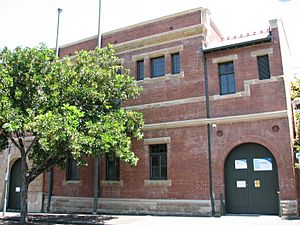Ultimo Sewage Pumping Station facts for kids
Quick facts for kids Ultimo Sewage Pumping Station |
|
|---|---|

Ultimo Sewage Pumping Station, Pyrmont Street, Ultimo, NSW
|
|
| Location | William Henry Street, Ultimo, City of Sydney, New South Wales, Australia |
| Built | 1899–1902 |
| Architect | New South Wales Department of Public Works |
| Architectural style(s) | Federation Free Style |
| Owner | Sydney Water |
| Official name: Sewage Pumping Station 1; SPS 1; SPS 0001; The Controlling Station | |
| Type | State heritage (built) |
| Designated | 18 November 1999 |
| Reference no. | 1336 |
| Type | Sewage Pump House/Pumping Station |
| Category | Utilities - Sewerage |
| Builders | New South Wales Department of Public Works |
| Lua error in Module:Location_map at line 420: attempt to index field 'wikibase' (a nil value). | |
The Ultimo Sewage Pumping Station is a very old building in Ultimo, Sydney, Australia. It is a special heritage-listed sewage pumping station. This means it helps move wastewater from homes and businesses. It was built a long time ago, between 1899 and 1902.
The station was designed by the New South Wales Department of Public Works. It is also known by other names like Sewage Pumping Station 1 or SPS 1. It was even called "The Controlling Station" because it managed other stations. Today, Sydney Water owns this important building. It was added to the New South Wales State Heritage Register in 1999, showing how important it is to history.
Contents
Why Was This Station Built?
Sydney's Early Sewage Problems
Back in 1859, Sydney's sewage system was very basic. Wastewater went straight into Sydney Harbour. By the 1870s, the harbour became very dirty. There were also many outbreaks of a serious illness called Enteric Fever, or typhoid. This was a big problem for people's health.
Finding Solutions for Clean Water
To fix this, the NSW Government created a special health board. They looked for better ways to get rid of Sydney's sewage. This led to building two main sewers in 1889. One was the Bondi Ocean Outfall Sewer, which took sewage to the ocean. The other sent sewage to a farm near Botany Bay.
Pumping Stations for Low Areas
Some areas near the harbour were too low for sewage to flow away by itself. So, pumping stations were needed. These stations would collect the sewage. Then, they would pump it up to the main sewer system. The Ultimo Pumping Station (SPS 1) was the first and largest of these new stations. It helped clean up the city and protect people's health.
What Does the Ultimo Pumping Station Look Like?
Building Design and Features
The pumping station has two main parts. There is a two-storey brick building above ground. Below ground, there are concrete areas for the machinery and sewage. The building's style is called "Federation Free Style." It uses different types of bricks and sandstone to look interesting.
The front of the building faces William Henry Street. It has a balanced design with three sections. The middle section has an entrance porch. You can see special stone details around the windows and roofline. The entrance has large wooden doors and a rounded arch.
Inside the Pumping Station
Inside, the ground floor has a lobby. From here, you can go upstairs to offices or downstairs to the machinery area. This floor also has space for storage. Upstairs, there were offices and a "controlling room." This room was where workers used to manage other pumping stations.
Changes Over Time
The outside of the building still looks much like it did when it was built. However, many of the original machines inside have been replaced. For example, the station used to control 17 other pumping stations, but this stopped around 1918. The old control panels were removed from the office upstairs. The building's power source also changed from direct current (DC) to alternating current (AC) around 1918.
Why is This Building Important?
A Piece of History
The Ultimo Pumping Station (SPS 1) is very important for its history. It was one of the first 20 sewage pumping stations built in Sydney. It played a key role in cleaning up Sydney Harbour. This helped stop serious diseases like typhoid from spreading. The station shows how Sydney grew and improved its public services in the early 1900s.
Beautiful Architecture
This building is also important for its design. It's a great example of the Federation Free Style of architecture. Even though it's an industrial building, it was built with great care and skill. Its size, colours, and details make it a special part of the Ultimo streetscape.
Smart Engineering
The underground parts of the station are also special. They show early and clever use of concrete in Australia. The station has been working for over a century, even with updated machines. It teaches us about how sewage systems and building designs have changed over time. It also shows the smart ideas of engineers from the past.
A Unique Landmark
SPS 1 is unique because it was the first and largest of its kind. It was also the "controlling station" for many other early pumping stations. This makes it a rare and important part of New South Wales's history. It continues to serve its original purpose, showing its lasting value.

